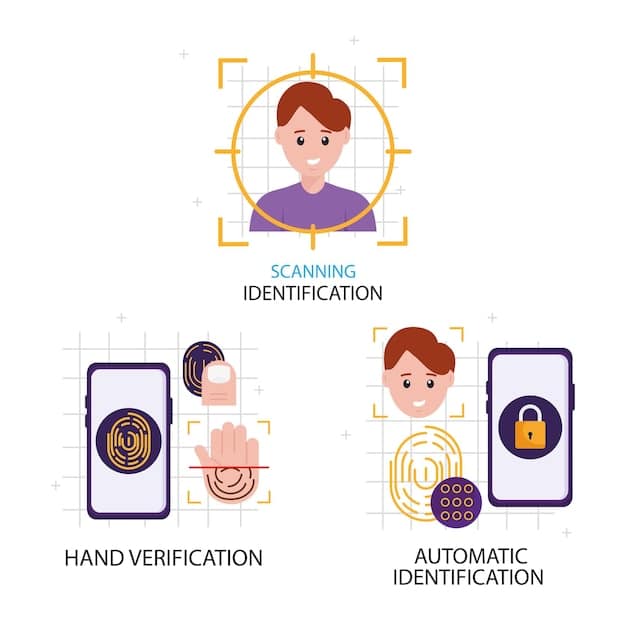Web3 and Cybersecurity: Protecting Your Data in the US

Web3 and Cybersecurity are inextricably linked, especially in the US, as decentralized technologies revolutionize data protection and necessitate robust security measures to safeguard user information and digital assets.
The intersection of Web3 and Cybersecurity: Protecting Your Data in a Decentralized World in the US marks a pivotal moment in how we approach digital security, demanding innovative solutions to safeguard the decentralized internet.
Understanding the Evolution: Web3 and Its Cybersecurity Challenges
Web3 represents a significant leap from the current internet landscape, promising greater user autonomy and decentralized control. However, this transition introduces novel cybersecurity challenges that demand careful consideration and proactive measures.
What is Web3?
Web3 is often referred to as the next generation of the internet, characterized by decentralization, blockchain technology, and token-based economics. Unlike Web2, where data and control are centralized in the hands of a few large corporations, Web3 aims to distribute power among users, fostering a more democratic and transparent online environment.
Key Differences from Web2
The shift from Web2 to Web3 brings fundamental changes to how data is stored, managed, and secured. In Web2, centralized servers are prime targets for cyberattacks, while Web3’s decentralized nature theoretically reduces the risk of single points of failure. However, this decentralization also introduces new attack vectors that cybersecurity professionals must address.
- Decentralization: Web3’s decentralized structure eliminates single points of failure.
- Blockchain Technology: Immutable ledgers enhance transparency and security.
- Token-Based Economics: Cryptocurrencies and NFTs introduce new security considerations.
Securing Web3 requires a new mindset and a fresh set of tools. While decentralization offers inherent advantages, it’s crucial to understand and mitigate the evolving threat landscape.
The Unique Cybersecurity Risks in Web3
Web3’s decentralized environment introduces a range of cybersecurity risks distinct from those in Web2. Understanding these unique challenges is crucial for developing effective security strategies and protecting user data.
Smart Contract Vulnerabilities
Smart contracts, self-executing agreements written in code, are a cornerstone of Web3 applications. However, these contracts are susceptible to vulnerabilities that can be exploited by malicious actors, leading to financial losses and data breaches.
Decentralized Autonomous Organizations (DAOs)
DAOs, organizations governed by code and community consensus, present new cybersecurity challenges. The decentralized nature of DAOs can make them vulnerable to attacks if security protocols are not rigorously implemented and maintained.

- Reentrancy Attacks: Attackers exploit vulnerabilities in smart contracts to drain funds.
- Governance Attacks: Malicious actors gain control of DAOs through compromised voting power.
- Immutability Challenges: Once deployed, smart contracts are difficult to modify, necessitating thorough audits.
Addressing these unique risks requires a proactive and comprehensive approach to cybersecurity, including rigorous code audits, robust access controls, and continuous monitoring.
Protecting Your Data: Best Practices for Web3 Security
Securing your data in the Web3 environment requires implementing best practices that address the unique challenges of decentralization and blockchain technology. By adopting a proactive approach, users and developers can mitigate risks and safeguard their digital assets.
Secure Wallet Management
Managing your cryptocurrency wallet securely is paramount. Choose reputable wallet providers, enable two-factor authentication, and store your private keys safely to prevent unauthorized access.
Smart Contract Audits
Developers should conduct thorough audits of their smart contracts before deployment. Engaging independent security experts to review code can help identify vulnerabilities and prevent costly exploits.
- Hardware Wallets: Store private keys offline for enhanced security.
- Multi-Factor Authentication: Add an extra layer of protection to wallet access.
- Regular Security Audits: Identify and address vulnerabilities in smart contracts.
Implementing these best practices will significantly enhance the security of your data and digital assets in the Web3 ecosystem.
The Role of Authentication and Authorization in Web3
Authentication and authorization are critical components of cybersecurity in the Web3 environment. These processes ensure that only authorized users can access sensitive data and perform specific actions.
Decentralized Identity (DID)
DIDs offer a privacy-centric approach to authentication, allowing users to control their digital identities without relying on centralized authorities. DIDs enhance security and protect user data by minimizing reliance on third-party intermediaries.
Zero-Knowledge Proofs (ZKPs)
ZKPs enable users to prove the validity of information without revealing the information itself. This technology has significant implications for enhancing privacy and security in Web3 applications, particularly in areas such as financial transactions and data sharing.

- Improved Privacy: Users control their data and minimize exposure to identity theft.
- Enhanced Security: Decentralized authentication reduces the risk of centralized attacks.
- Greater Interoperability: DIDs enable seamless interaction across different Web3 platforms.
By incorporating DIDs and ZKPs, Web3 applications can provide robust authentication and authorization mechanisms while safeguarding user privacy and security.
Navigating the Regulatory Landscape in the US
The regulatory landscape for Web3 and cybersecurity in the US is evolving rapidly. Understanding the current regulations and anticipating future changes is crucial for businesses and individuals operating in this space.
Current US Regulations
Existing regulations, such as the Cybersecurity Information Sharing Act (CISA) and the California Consumer Privacy Act (CCPA), have implications for Web3 businesses operating in the US. Compliance with these regulations is essential to avoid legal and financial penalties.
Future Regulatory Trends
As Web3 technologies continue to develop, it is likely that new regulations will be introduced to address emerging risks and protect consumers. Keeping abreast of these trends and adapting security practices accordingly is vital for long-term success.
- SEC Regulations: Scrutiny of cryptocurrency offerings and exchanges.
- Data Privacy Laws: Protecting user data in decentralized applications.
- Cybersecurity Standards: Establishing guidelines for securing Web3 infrastructure.
Navigating the regulatory landscape requires a proactive approach, including engaging with legal experts, monitoring regulatory developments, and implementing robust compliance programs.
The Future of Cybersecurity in the Decentralized Web
As Web3 continues to evolve, the future of cybersecurity in the decentralized web will be shaped by technological advancements, regulatory developments, and the growing awareness of security risks. Staying ahead of the curve will be essential for protecting data and ensuring the long-term viability of Web3.
Emerging Technologies
Technologies such as artificial intelligence (AI) and machine learning (ML) are playing an increasingly important role in cybersecurity. AI-powered tools can automate threat detection, enhance incident response, and improve overall security posture.
Community-Driven Security
The Web3 community has a crucial role to play in fostering a secure environment. Collaborative efforts, such as bug bounty programs and open-source security tools, can help identify and address vulnerabilities more effectively.
- AI-Powered Threat Detection: Automated analysis of network traffic and system logs.
- Blockchain-Based Security Solutions: Immutable logs and decentralized security protocols.
- Quantum-Resistant Cryptography: Protection against future quantum computing threats.
The future of cybersecurity in Web3 depends on continuous innovation, collaboration, and a commitment to protecting the decentralized ecosystem.
| Key Aspect | Brief Description |
|---|---|
| 🛡️ Smart Contracts | Ensuring security through audits and best coding practices. |
| 🔑 Wallet Security | Protecting private keys and using hardware wallets. |
| 🌐 Decentralized ID | Managing digital identities securely and privately. |
| 🏛️ Regulatory Compliance | Staying informed on cybersecurity laws in the US. |
Frequently Asked Questions (FAQ)
▼
Web3 is the next evolution of the internet, characterized by decentralization and blockchain technology. Unlike Web2, where data is centrally controlled, Web3 aims to distribute power among users through blockchain and token-based economics.
▼
Web3 introduces unique risks such as smart contract vulnerabilities, DAO governance attacks, and potential exploits of decentralized infrastructure. These risks require specialized security measures.
▼
Secure your crypto wallet by using hardware wallets, enabling multi-factor authentication, and storing your private keys offline. Also, be cautious of phishing attempts.
▼
DIDs allow users to manage their digital identities without relying on central authorities, increasing privacy and security. Users maintain control over their data and minimize the risk of centralized data breaches.
▼
The US regulatory landscape is evolving with increased scrutiny on cryptocurrency exchanges, data privacy, and cybersecurity standards. Staying informed on these developments is crucial for businesses in the Web3 space.
Conclusion
In conclusion, securing the decentralized future of Web3 requires a multifaceted approach encompassing technological innovation, regulatory awareness, and community collaboration. By understanding the unique cybersecurity risks and implementing best practices, users and developers can pave the way for a safer and more resilient Web3 ecosystem in the US.





